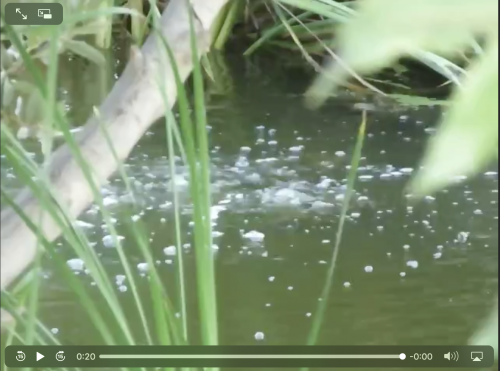Submitted on
Playa Vista perpetuates the 30 year old Salt Water Myth...
The Freshwater Marsh system was designed for ... ”controlling overflows to ensure the salt marsh did not receive an excess of freshwater.” (quote from page 2 paragraph 3 - PDF Letter from Playa Vista's Huffman to LARWQCB).
Huffman references the unscientific hearsay language of the 1990 Settlement Agreement, that mislabeled Ballona as a salt marsh. The permits were based upon this erroneous language that perpetuates the myth of having to save Ballona from its own historic freshwater resources. Ballona does not need to be saved from itself.
LA Regional Water Control Board answers from Playa Vista in
response to issues posed by Grassroots Coalition...
PV's diversion and throw away of freshwater from Ballona's freshwater dependent wetlands.
Reality - For 4000 years Ballona has been a predominantly Seasonal Freshwater Wetland.
Scientific studies have already demonstrated Ballona is a predominantly seasonal freshwater system. Agencies should be protecting Ballona’s freshwater resources based upon the available scientific knowledge. Proof below:
May.8.2019.Ballona.Wetlands.Restoration.History.Presentation.pdf
GC YouTube CCC Ballona Wetlands History Presentation May 8, 2019
a. 1959 Poland Report etal (hydrology report of LA Basin)
b. 1954 Congressional House Doc 389 and 780 establish Marina del Rey
Complete 47 pages MDR House Document No. 389 SMB - Public Law 389 5:11:1954 47 page pdf
Annotated House Document No. 780 SMB - Public Law 780 9-3-1954 Rivers and Harbors Act 2 page pdf
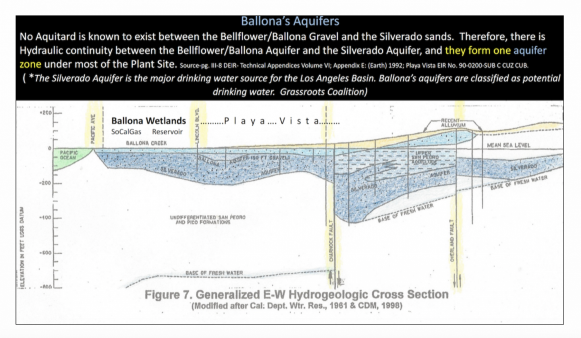
2. HISTORICAL ECOLOGY OF THE BALLONA CREEK WATERSHED — LONGCORE et. al.
3. 2012 Implications Ballona Wetlands Restoration, Dr. Travis Longcore video)
4. Youtube California Coastal Commission Meeting May 2019 Margot Griswold, Restoration Ecologist
LA Regional Water Control Board on 2/25/19..
GC also asks for a multi-agency review of the hydrology of Ballona Wetlands Ecological Reserve.
Good Morning Mr. Kang and Ms. Williams,
SaveBallona.org/president.presentations/ballona-wetlands.legal.review.2006.html
comments and allegations in his 2/25/19 letter to LARWQCB is provided below.
-
GC did not assert that the ‘Freshwater Marsh’ is unlawfully diverting freshwater from Ballona Wetlands to the Ballona Channel leading to the ocean.
GC does assert that the oversight/management of the Freshwater Marsh System is diverting freshwater from Ballona Wetlands to the Ballona Channel leading to the ocean.
GC asserts that this diversion and throw-away of freshwater is harmful to the ecosystem of Ballona Wetlands which includes the underlying freshwater aquifers.
PCC acknowledges on page 2 — paragraph 3
the Freshwater Marsh System was created to provide drainage for the Playa Vista Project that would support development of the Playa Vista Project.Prior to Playa Vista the watershed's groundwater and rainwater flowed into Ballona Wetlands.
-
It is well established that wetlands act as a natural cleansing basin for water that flows through them. Ballona was not in need of any artificial catch-basin of Playa Vista installation and was not in need of the illegal drains that Playa Vista installed and is definitely not in need of having its freshwater resources thrown away into the the ocean or into the sanitary sewer.
-
The catch basin system is a flood control component for Playa Vista to continue its build out. But for this system (or other flood control system), the Playa Vista development site would not, ostensibly, be permitted. It appears to GC, that by allowing Playa Vista to maintain its conflicted oversight of this public trust land, it obliges a ‘gifting’ of public resources. It is Playa Vista that benefits from this ‘system’, the environment of Ballona Wetlands Ecological Reserve is harmed by Playa Vista’s diversion of Ballona’s freshwater, away from Ballona Wetlands Ecological Reserve. The precious freshwaters are thrown away into the ocean. There is no benefit to the public’s Ballona Wetland Ecological Reserve.
Any take away of Ballona’s freshwater is harmful to Ballona Wetlands Ecological Reserve. There is no excuse for throwing away this precious, life-giving water.As cited in the California Coastal Commission (CCC) Letter (4/11/14) to Playa Vista and CDFW … draining Ballona is harmful to the ecosystem:“… a water supply of a reliable quantity and quality is needed thus contributing to the habitat function of the larger Ballona Wetland project instead of directing it away from habitat regs within the Ballona Wetlands Ecological Reserve.” (p. 3 of 9 4/11/14 CCC Letter to Playa Capital LLC and to CDFW re: unpermitted drains)
“… a continuous detriment to wetland hydrology and habitat that relies on water to function.”“… degradation of wetland function through alteration of hydrology means that the same plants may not grow and habitat value and wildlife use of the wetland are reduced.” (p. 8 of 9 4/11/14 CCC Letter to Playa Capital LLC and CDFW)Every year California Department Fish & Wildlife (CDFW) allows Playa Vista to drain the freshwater marsh water into the ocean rather than allow the freshwater to stay in Ballona Wetlands.
As discussed by Lisa Haage lead of CCC enforcement, referencing that taking away water from a wetland is the exact opposite of what one would allow in a wetland:
“We think that draining a wetland is about the most amazing violation that you could have.”“I mean, putting a drain in a wetland is exactly the opposite of anything that you’d do in a wetland.”(December 14, 2017 Dana Point CCC Meeting Item 10 C)HOW TO DRAIN A WETLAND AND GET AWAY WITH IT; THE BETRAYAL OF THE PUBLIC’S TRUST.
http://www.saveballona.org/how-drain-wetland-and-get-away-it-betrayal-publics-trust.htmlGC maintains that the freshwater sent into the Freshwater Marsh System needs to be ultimately conveyed from there, into Ballona Wetlands Ecological Reserve, and NOT thrown away into the ocean and/or the sanitary sewer system.
-
Draining, diverting, taking away, throwing away the freshwater marsh’s water and the pumping and throw-away of groundwater from under buildings for the gas mitigation systems, sending it into the sanitary sewer, as well as pumping clean groundwater into the freshwater marsh system which is ultimately sent into the Ballona Channel is all unnecessary, and a wasteful use of clean freshwater that is Ballona’s heritage of freshwater resources. GC has provided groundwater protection laws and premises set by the Department of Water Resources (Resolution No. 88-88) to LARWQCB. Resolution 88-88 renounces wasteful practices similar to those being practiced by Playa Vista and are harmful to Ballona Wetlands Ecological Reserve. Any dewatering, any take away of Ballona’s freshwater assets constitutes harm to this wetland.
-
EX Parte ... Freshwater Marsh [Web Editor: quote from PDF page 2 of 5 - 763 kilobytes] -
"CDFW explained that the Marsh is not part of the Ballona Wetlands but rather leased to another property owner by State Lands Commission. They do not manage or own the spillway from the Marsh runoff. The staff agree with the concerns raised by the NGO community regarding the run off and the efforts to manage the unconnected creek. CDFW indicated that it is not diverting any of the fresh water from the marsh. There are ongoing efforts to coordinate between the owners of the fresh water marsh and the Ballona Reserve. They mentioned that the groundwater being pumped is another legacy element as it is from an old Hughes Aircraft manufacturing plant. This is part of a mitigation program to clean up the groundwater and after toxins are removed, to run it through the wetlands."
- Clearly, throwing the mitigation program water either into the sanitary sewer or out to sea, DOES NOT RUN IT THROUGH THE WETLANDS. RUNNING IT THROUGH THE WETLANDS IS EXACTLY WHAT WE SEEK TO OCCUR, AND IS NOT HAPPENING.
CCC YouTube CCC 3.6.19 https://youtu.be/VPsSlqo5Tzc - Clearly, the Ex Parte above between Coastal Commissioner Brownsey and CDFW demonstrates further confusion and disjointed oversight of Ballona Wetlands.
According to PCC, Mr. Huffman, the CDFW plays a key role of oversight of the Freshwater Marsh System via the CDFW Streambed Alteration Agreement and via the monitoring reports of the Freshwater Marsh System.“In addition to these permits, the construction, operation and long-term maintenance of the Freshwater Wetland System are governed by a California Fish and Game Code Section 1603 Streambed Alteration Agreement from California Department of Fish & Wildlife (“CDFW”)", ...(P. 3, Paragraph 6) This is not being enforced.
Yet, CDFW is telling the Coastal Commissioner (in the Ex Parte) that CDFW has no authority or management of the freshwater spillway and marsh runoff.
On the other hand, CDFW claims to other entities that it is a board member of the Ballona Conservancy, which is claimed to also have management oversight of the Freshwater Marsh System. (Slide 26 - Ballona Wetlands History SlideShow)
Which is it? GC requests there be a multi-agency review of these issues which includes the public as part of this conversation about who has authority over what, alongside a conversation of how to end the needless throw away of freshwater from Ballona Wetlands.
The Ballona Wetlands Conservancy is a Playa Vista construct whose Board members are not made clear to the public or agency personnel and leadership. It is not a part of the 1990 Settlement Agreement.(GC provides Public Record Act responses to Mr. John Davis regarding these matters as a separate attachment due to its length.)PCC fails to mention its EIR (’93) and the attendant mitigation which requires Playa Vista, to maintain a beneficial use of treated water to benefit the wetland vegetation. See citations below. - Clearly, throwing the mitigation program water either into the sanitary sewer or out to sea, DOES NOT RUN IT THROUGH THE WETLANDS. RUNNING IT THROUGH THE WETLANDS IS EXACTLY WHAT WE SEEK TO OCCUR, AND IS NOT HAPPENING.
“Before any long term dewatering is conducted, a plan for the beneficial use of any water which is produced shall be submitted and approved by the appropriate City agency.”Enforcement Agency: Department of Building & Safety, and Regional Water Quality Control BoardPage 10 J. Appendix D — Mitigation Monitoring and Reporting Program
B. “A stormwater management district, or equivalent, shall be established satisfactory to the Advisory Agency and the City Engineer for the future operation and maintenance of the freshwater wetland system, the riparian corridor and other necessary drainage facilities.”
Vesting Tentative Tract No. 49104 - Agreements (further citations are contained in the EIR sections)
A. “Prior to issuance of any grading or building permits, the applicant shall submit plans, satisfactory to the Advisory Agency, for construction of the Freshwater Wetland and Riparian Corridor consistent with (a) concepts provided in the Final EIR which have been reviewed and approved as to concept by the Dept. of Public Works of the City of Los Angeles and (b) the permits granted by the U.S. Corps of Engineers and the California Coastal Commission. In addition, the California Coastal Commission must provide approval of the final construction plans for the freshwater wetland system. A plan to guarantee maintenance of the Freshwater Wetland system in perpetuity shall also be provided. … The Plan shall include … a wetland maintenance plan, including funding mechanism to assure the plan will be implemented. The plan shall also include the … biological consultant selected by the Ballona Wetlands Committee to monitor … [emphasis added]
Paleontologic Resources
B. If stabilization of the bluffs in Area D is required, a paleontologist shall monitor ground-disturbing activities on a full-time basis during grading in those areas where the San Pedro Formation would be disturbed …
II. PROJECT OBJECTIVES
C. Environmental Objective — To comply with the conditions of the Settlement Agreement and to enhance the public acceptance … to create an ecologically sound development of the property at Playa Vista which implements a comprehensive program of resource protection, enhancement, conservation and reuse.
… ”Before any long-term dewatering is conducted, a plan for the beneficial use or discharge of any water which is produced shall be submitted and approved by the appropriate City agency.”
“The project’s planned remediation of contamination and utilization of treated water for supporting wetlands vegetation would result in a beneficial impact on ground water in the area."
-
While Grassroots Coalition (GC) agrees that Permits were approved — namely CDP 5-91-463 and 90-426 EV; Grassroots Coalition (GC) thoroughly disagrees with Playa Capital Company’s contention that the Freshwater Marsh System operates as it was intended. Oversight has been lacking and agencies have been disconnected in their oversight functions which has given rise to unaddressed problems that are harmful to Ballona Wetlands Ecological Reserve.Settlement Agreement — California Coastal Commission vs Friends of Ballona et al 1990
-
The Permits were not analyzed as part of any Environmental Impact Report, contrary to this assertion by PCC.
Numerous environmental protective evaluations that are typical of the California Environmental Quality Act (and the CCC equivalent review) were set aside and never occurred. There was no scientific analysis performed for CDP 5-91-463 which inculcates the Army Corps Permit 90-426-EV. Instead, Ballona Wetlands was MISCHARACTERIZED as a salt marsh in the 1990 Settlement Agreement which is the basis of CDP 5-91-463. This inaccurate/ false premise set the stage-improperly- for the current Draft Environmental Impact Report —which provides only for the creation of a salt marsh, while promoting the destruction of ‘restoration’ and Ballona Wetlands. Perhaps, this is believed to have occurred because Playa Vista has controlled the outcome of Ballona Wetlands for its own flood control goals and needs as well as Tsunami protection goals and needs.
Playa Vista’s needs are disallowed to harm Ballona Wetlands Ecological Reserve … as stated in the 1990 SA/2006 Stipulation.The public paid over $140 million dollars for the acquisition of Ballona Wetlands. It has been given the highest protective nomenclature — the status of Ballona Wetlands Ecological Reserve by the Fish and Game Commission. Restoration only is allowed under the California Coastal Act.In PCC’s Letter, PCC uses the inaccurate, hearsay of Ballona being a salt-marsh … as an excuse to drain, divert and pump away Ballona’s freshwater. PCC FAILS to mention its own EIR mitigation measures intended to protect and enhance the habitat of Ballona Wetlands.Download the 43 megabyte Slideshow PDF: California Coastal Commission Meeting - May 8, 2019 - Ballona Wetlands Restoration History
-
Playa Capital Company (PCC), in their letter response, attempts to perpetuate their myth of Ballona Wetlands being a salt marsh. We can only assume it is due to their private needs of flood control.
Ballona Wetlands is a predominantly seasonal freshwater wetland system, rare to the coast of California.
Ballona Wetlands History SlideShow (Slides 18-21 of 31) May 8, 2019;
GR YouTube CCC Ballona Wetlands History Presentation May 8, 2019 CCC Ballona Wetlands History Presentation by Patricia McPherson; -
-
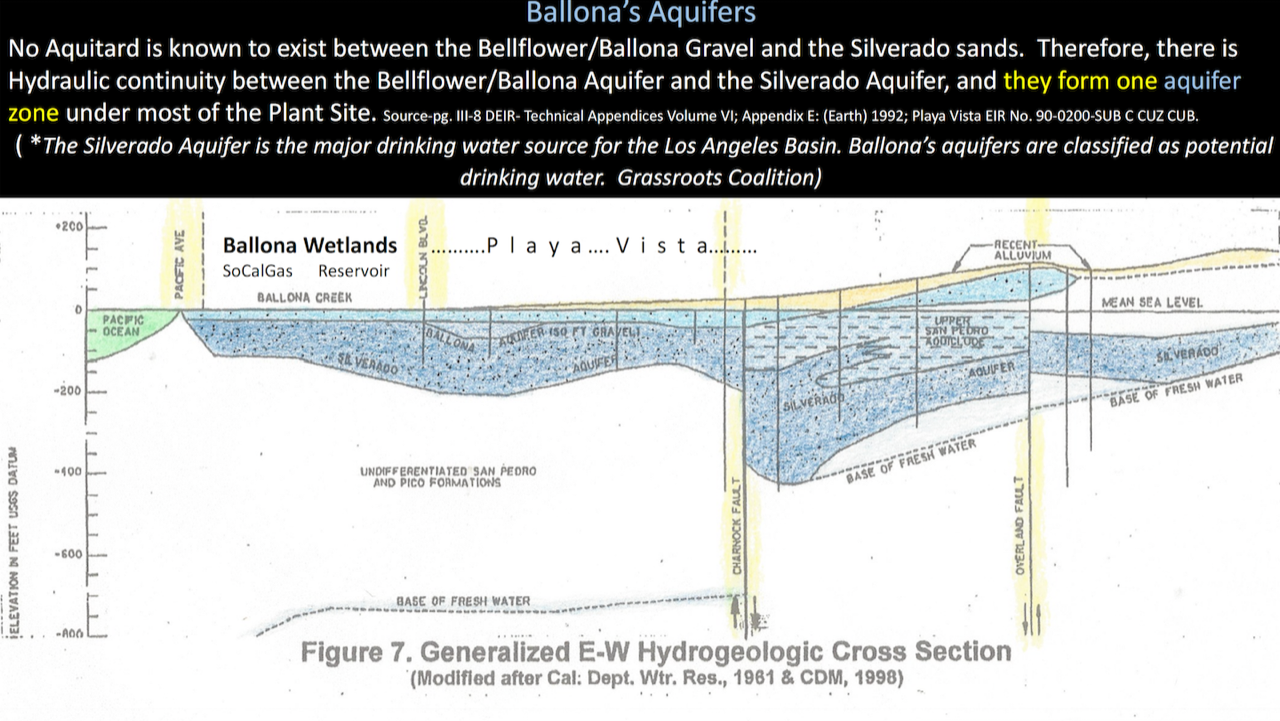 The freshwater marsh system was designed to overflow into Ballona Wetlands. Nothing, in any of the permits, allows for harm to Ballona Wetlands. To the contrary, the 1990 Settlement Agreement and its subsequent Stipulations (eg 2006) specifically disallow any harmful actions by Playa Vista to occur to Ballona Wetlands.As LARWQCB is fully aware, the California Coastal Commission (CCC) found that the illegal drains inserted by PCC and maintained by both PCC and CDFW were a Violation of the Coastal Act due to their harm to Ballona Wetlands via the illegal drainage.PCC/Brookfield (Playa Vista) had continually argued, since 2016, to the CCC that these drains were inconsequential and no rainwater ponding occurred in this area. Playa Vista and their consultants were proven wrong.The CCC Commissioners ordered the illegal drains capped and for CDFW to provide an application to REMOVE THE DRAINS.The rains of 2019 have demonstrably proven that with the capping of the drains, ponding is restored to Ballona Wetlands in these areas of endangered wetland habitat.
The freshwater marsh system was designed to overflow into Ballona Wetlands. Nothing, in any of the permits, allows for harm to Ballona Wetlands. To the contrary, the 1990 Settlement Agreement and its subsequent Stipulations (eg 2006) specifically disallow any harmful actions by Playa Vista to occur to Ballona Wetlands.As LARWQCB is fully aware, the California Coastal Commission (CCC) found that the illegal drains inserted by PCC and maintained by both PCC and CDFW were a Violation of the Coastal Act due to their harm to Ballona Wetlands via the illegal drainage.PCC/Brookfield (Playa Vista) had continually argued, since 2016, to the CCC that these drains were inconsequential and no rainwater ponding occurred in this area. Playa Vista and their consultants were proven wrong.The CCC Commissioners ordered the illegal drains capped and for CDFW to provide an application to REMOVE THE DRAINS.The rains of 2019 have demonstrably proven that with the capping of the drains, ponding is restored to Ballona Wetlands in these areas of endangered wetland habitat. -
ALLEGED CLEAN WATER ACT VIOLATION. The LARWQCB is aware from Playa Vista emails provided to LARWQCB by GC, that consultants of Playa Vista-namely Psomas, have acknowledged in emails to Playa Vista, CDFW and others, that the water of the Ballona Channel periodically backs up into Ballona Wetlands via the previously uncapped drains.GC believes this ‘back flow into Ballona Wetlands” to be a violation of numerous environmental laws but additionally believes that this unpermitted Ballona Channel water flow INTO Ballona demonstrates the failure of the Main Drain to function as permitted. This matter needs to be addressed by LARWQCB per the Clean Water Act and other state water/wetland protective laws. The failure of the Main Drain to act as permitted needs to also be addressed by the USACE & County Flood Control as well as by the Ca. Coastal Commission, CDFW and all the entities that are part of the Freshwater Marsh System oversight.PAGE 2 paragraph 2PCC provides inaccurate information to the LARWQCB. The Ballona Wetlands Conservancy was NOT a part of the Settlement Agreement. (See Davis PRAs)Pursuant to the settlement agreement mentioned above the Friends of Ballona Wetlands, the State of California, the City of Los Angeles, and MTP-PV, the Ballona Wetlands Conservancy was formed in 2000 to manage the Freshwater Marsh, and has managed the system since the initial portions were completed in 2003. The Board for the Conservancy is comprised of representatives appointed by the Resources Secretary of the State of California, Los Angeles City Council District 11, the Friends of Ballona Wetlands, and Playa Capital Company LLC. Funding for the Conservancy is provided through assessments of properties within the Playa Vista community. The biologist who performs the management of the Freshwater Wetlands System is Dr. Edith Read, PhD.As can be seen by reading the Settlement Agreement (SA), the Ballona Wetlands Conservancy WAS NOT A PART OF THE SA.Pursuant to the SA of 1990-1, the Ballona Wetlands Committee was to be formed. The parties of the Ballona Committee, according to the SA were to consist of representatives of the State Lands Commission; the Council District; Maguire Thomas Partners (Playa Vista) and the Friends of Ballona who were in turn, to create the Ballona Wetlands Foundation (same representatives) for oversight and management of the Ballona restoration and the freshwater marsh system.Playa Vista, itself, created the Ballona Wetlands Conservancy (Conservancy) in 2000. It appears to be part of a narrative designed to provide both obfuscation and confusion. The IRS records show the Conservancy as being Playa Vista entities (See IRS Records at Bottom within Additional Information).
-
Even the Friends of Ballona involvement in anything Ballona, by this timeframe is under the oversight and direction of Playa Capital LLC VIPs and/or its consultants as they became the leadership of Friends of Ballona Wetlands.- In the Ballona History SlideShow - Slide 27, discusses the Conservancy as formed to provide the financing to be made available for management of the freshwater marsh system. When the freshwater marsh was first acquired by the public it was held in trust by the State Lands Commission and an independent company provided oversight of the management of the marsh. Later, Edith Read, PhD. a biologist and Playa Vista consultant, took over that role.
What is left out of this oversight, is engineering oversight for how the marsh actually functions.
-
Hence, the failure of the Main Drain to act as permitted, (the back-flow from Ballona Channel entering Ballona Wetlands Ecological Reserve via the illegal drains) has not been part of the oversight of Ms. Read as shown in the monitoring reports. The Habitat Mitigation and Monitoring Program (HMMP) is flora and fauna and water QUALITY oriented FOR ONLY CERTAIN CHEMICALS.HUGE DATA GAPS
-
Lack of prudent, active oversight by multiple agencies appears to have occurred which has allowed for the Operations and Maintenance Manual for this flood control system, to not be finalized and no permit established as a FLOOD CONTROL Permit for the Main Drain’s exit breech to the Ballona Channel from LA County Flood Control.
-
There are huge data gaps that have occurred that include, but are not limited to:
-
Patricia McPherson President of Grassroots Coalition presents History of SoCalGas Underground Gas Storage Field Operations
-
-
YouTube:
-
"How Hazardous is too Hazardous", by Grassroots Coalition's Patricia McPherson
-
-
Slides of the Presentation:
-
-
The YouTube Presentation and Slide Presentation were given to the City of Los Angeles for a Compliance Review Request #453028 August 2, 2019, for the Conditional Use Permit of SoCalGas/PDr by Grassroots Coalition and supported by the Sierra Club.
-
-
-
Monitoring of the oilfield outgassing that is occurring on a daily basis both directly over the Playa Vista abandoned well - University City Syndicate and approximately 100 feet east of the well itself. DOGGR has documented the oilfield outgassing over University City Syndicate (location of well head via a magnetometer) and GPS’d the location. Exploration Technologies Inc (ETI). (LA City Oilfield Gas Expert 2000-01) has already documented SoCalGas’s acknowledgement of numerous wells within their mineral right area as being used as conduits for migrating oilfield gas. ETI has cited this observation and condition, and noted that by, law, is not allowed under DOGGR regulations. The fact that DOGGR has done nothing to compel Playa Vista to end the outgassing directly over University City Syndicate, GC would opine, is more a matter of politics and favors than legal reality.
-
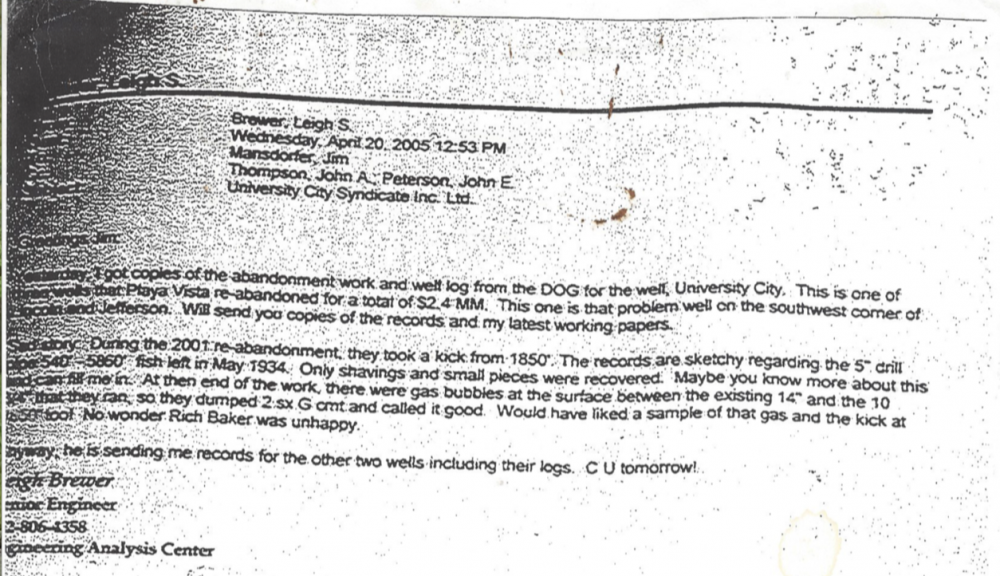
The Memo above from Leigh Brewer (SoCalGas) to Jim Mansdorfer and John Thompson (both senior SoCalGas personnel) acknowledges SoCalGas’ awareness of University City Syndicate as a ‘problem well’ and goes on to cite that during the (Playa Vista) re-abandonment, “they took a kick (blowout) from 1850.” The memo addresses the leakage at the surface “At the end of the work, there were gas bubbles at the surface … so they dumped 2sx (sacks) G cmt (cement) and called it good. ... No wonder Rich Baker was unhappy.” Richard Baker was then in charge of the Cypress DOGGR office. (Document courtesy Bernard Endres, PhD.)Read the 2005 email immediately above. Then Click on photos below to see 2017 and 2019 videos of outgassing over University Syndicate.
- Playa Capital Company (PCC) makes a claim of the outgassing not being over University City Syndicate. The comment is simply inaccurate.
-
https://youtu.be/LR1r9X2VGZo Outgassing over University City Syndicate (DOGGR PRA FILE)Note the heightened outgassing occurring in 2017— https://www.flickr.com/gp/stonebird/5KU61h (Jonathan Coffin video)
-
Here are the wetlands: https://youtu.be/QDXIPAYaCHA
This is recent - 2019, FLIR imaging showing the oilfield gas off gassing over University City Syndicate.
- EarthWorks & GC2019 Oilfield outgassing over Playa Vista’s abandoned oil well- University City Syndicate in freshwater marsh (public trust land/water) https://www.flickr.com/gp/stonebird/2h5k6L
-
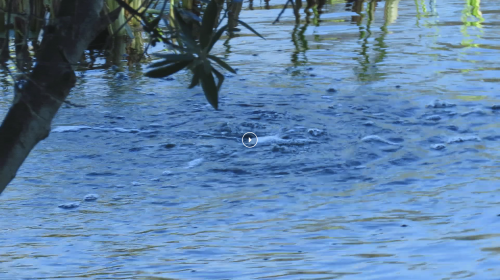
2019 Oilfield outgassing near (west) University City Syndicate in freshwater marsh (public trust lands/water)https://www.flickr.com/gp/stonebird/J1Sc3k
-
PAGE 3 - Playa Capital Company (PCC) Letter https://drive.google.com/file/d/1t1m6whXly8ChvPWADk0OJcddg3BxgOcx/viewUSACE PERMIT NO. 90-426 EV … while this permit exists, PCC uses it as an apparent excuse to divert freshwater away from Ballona Wetlands and thereby harming Ballona Wetlands Ecological Reserve. There is nothing in this permit that allows for harming the Ballona Wetland Ecosystem and its underlying aquifers.The Corps’ role in this permit envisioned the freshwater marsh system water to flow out upon Ballona as designed in the extended wetland portion. The acceptance of the Corp to allow flow into Ballona Channel discusses the approval as based upon the volumes sent into the Channel being marginal compared to the Channel’s capacity for water flow, hence the Corps determined no harm would come to the Channel from the added flow. Therefore, the Corps, as cited in its letters to PCC approved the breech in the Channel levee. The Corps’ permitting did not investigate the ecological needs of Ballona Wetlands.The Playa Vista EIR did contemplate Playa Vista dewatering for the Hughes contamination. However, the cleansed water was cited as being used thereafter in a beneficial manner for the wetlands. The permits garnered by Playa Vista for the Freshwater Marsh System, discuss the lack of knowledge as to how much fresh water is needed for Ballona Wetlands.The build out of Phase 2 of Playa Vista also provides for removal of groundwater and rainwater via the riparian corridor . The Phase 2 EIR discusses the lack of knowledge that would exist until completion of Phase 2, as to how much water diversion would occur.The Phase 1 EIR did not contemplate the need for dewatering under buildings due to the need to lower the water table away from the gas intake pipes of the gas mitigation systems. The later CLA Report had no cumulative dewatering calculations and only included approximately 5 buildings of Playa Vista analyzed in a model format and not with actual Department of Sanitation volumes .There remains a need for a cumulative evaluation of the full dewatering that is ongoing by Playa Vista. Ultimately, there is no reason for Playa Vista to throw away the groundwater and rainwater (which is classified as nuisance water at Playa Vista).The freshwater simply needs to be restored to Ballona Wetlands Ecological Reserve instead of being thrown away.
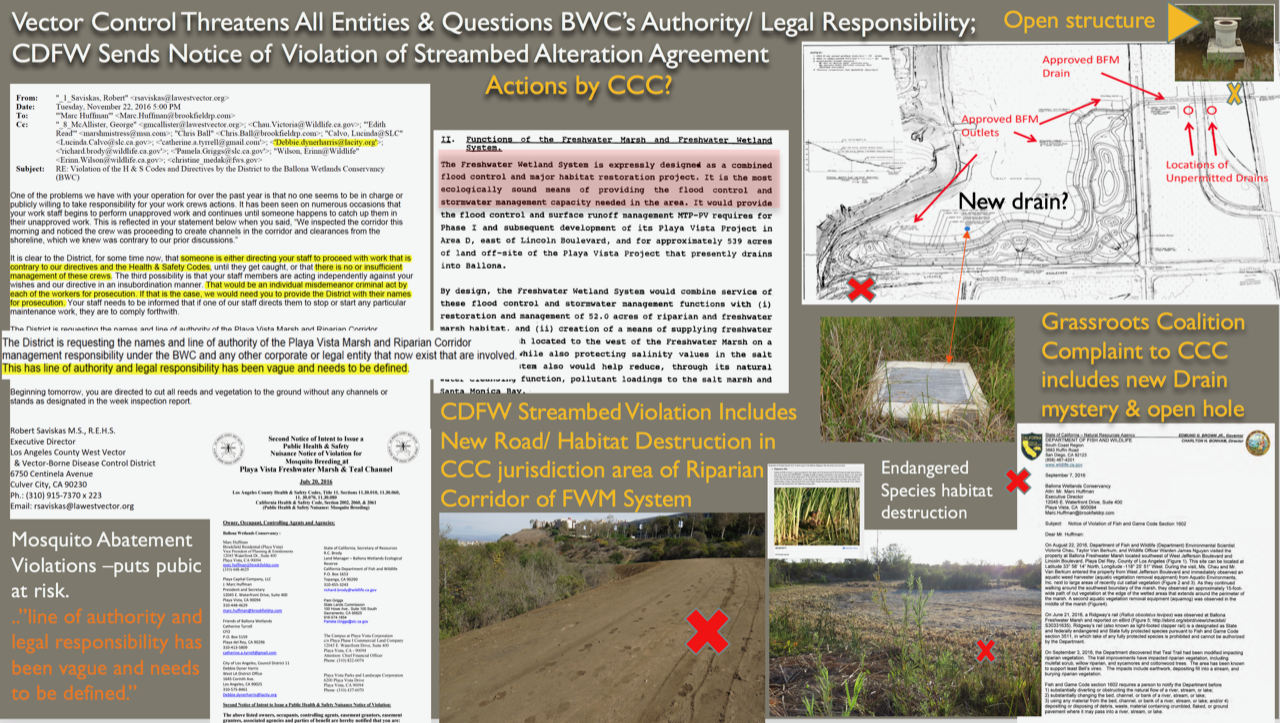
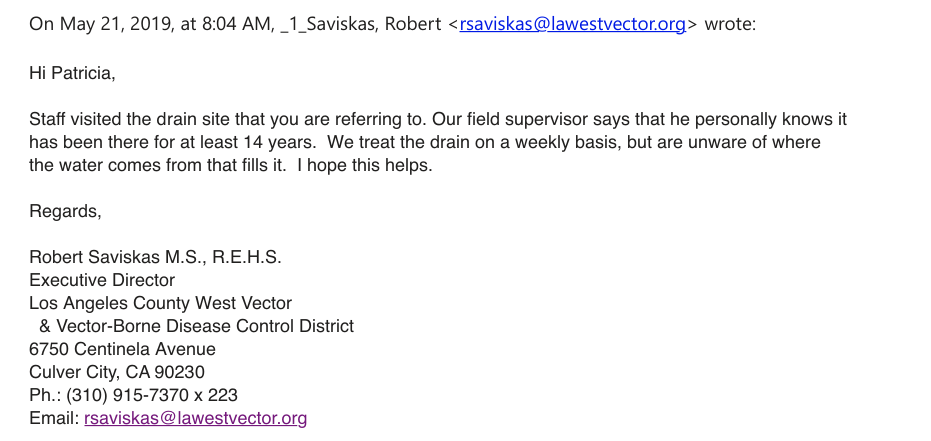
Here is the wetlands: https://youtu.be/QDXIPAYaCHA
This is recent - 2019, FLIR imaging showing the oilfield gas off gassing over University City Syndicate.
- EarthWorks & GC
2019 Oilfield outgassing over Playa Vista’s abandoned oil well- University City Syndicate in freshwater marsh (public trust land/water) https://www.flickr.com/gp/stonebird/2h5k6L
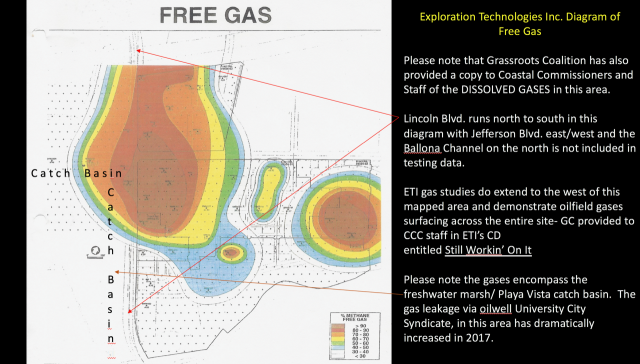
2019 Oilfield outgassing near (west) University City Syndicate in freshwater marsh (public trust lands/water)https://www.flickr.com/gp/stonebird/J1Sc3k
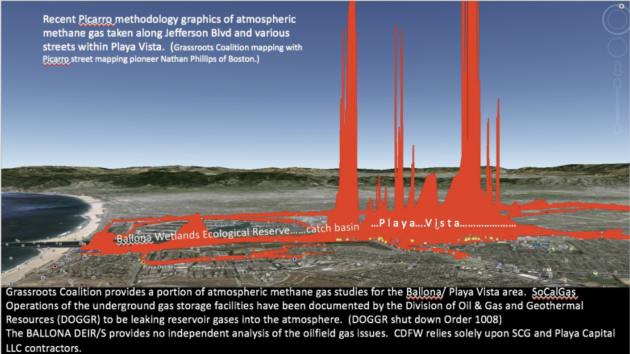
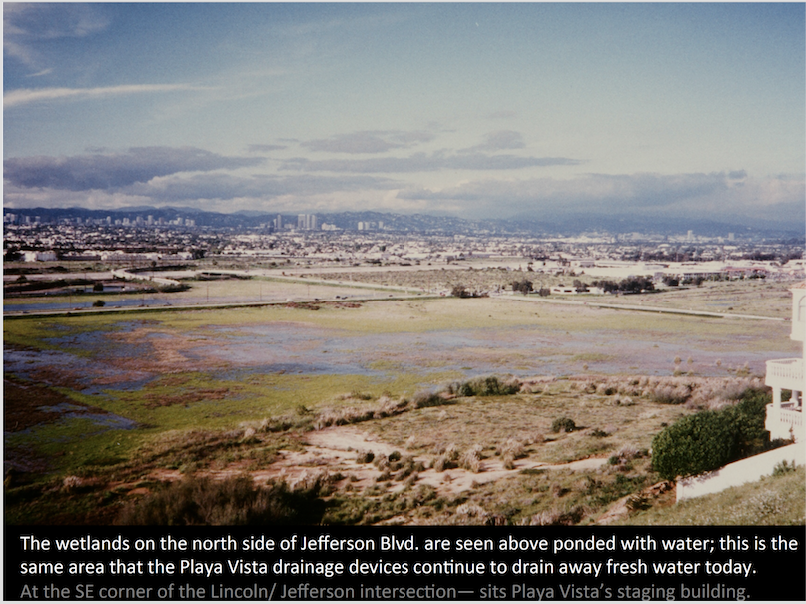
WATCH 2012 Implications Ballona Wetlands Restoration, Dr. Travis Longcore video)
PCC should not have direct oversight of the FWM system. Its interests are highly conflicted and provide no benefit to Ballona Wetlands Ecological Reserve.
Hello Mr. Kang and Ms. Williams,
Provided below are further attachments for Grassroots Coalition’s response to Playa Vista letter to LARWQCB on 2/25/19 regarding Grassroots Coalition’s information provided to LARWQCB.
BTW — THE VERBAL MOTION OF 6/30/05 attached*, we believe has been violated by Playa Vista. With respect to a.
“The Developer agrees not to seek any new or modified approvals that would have an impact materially more adverse than that permitted by the development currently approved, as a contractual matter, that it will not complete the final phase of the development until it has completed all the required traffic and ecological improvements.”
We believe that the CA. DEPT. OF FISH & WILDLIFE STREAMBED VIOLATION NOTICE per the destruction of Riparian Corridor habitat and Playa Vista’s unpermitted development of a massive new roadway in the same corridor (which previously contained an approved, small access PATHWAY) alongside Playa Vista destruction of habitat in endangered species habitat areas of both the Riparian Corridor and the Freshwater Marsh area — constitutes a breach of the City agreement.
Thank you,
Patricia McPherson, GC
Attachments:
John Davis Public Record Act information re: Who is Ballona Conservancy - PDF - 5.4 megabytes
2006 Stipulation update to 1990 CCC Settlement Agreement - No harm to Ballona - PDF - 6.7 megabytes
DOJ letter: Fast tracking of Settlement Agreement eliminates environmental studies - Word Docx - 3 pages - 4 megabytes
* Courtesy of Tongva Ancestral Territorial Tribal Nation (TATTN)
IRS Forms 2014 - 2015 - 2016
Ballona Wetlands Conservancy's actions of drying/draining/dewatering harms the Wetlands, it does not nourish them, a direct contradiction to their Mission Statement to preserve environmentally sensitive wetlands.
The B.W. Conservancy is demonstrably not the Committee referenced in the DOJ LETTER, which includes agency and Council District oversight. The B.W. Conservancy, as is seen in the personal signatures of the board, appears as a wholly private business representing Playa Vista residents, whose oversight of their flood control system/catch basin (aka freshwater marsh system) benefits Playa Vista.
The oversight by the Ballona Conservancy pumps, diverts and throws away Ballona’s freshwater resources away from Ballona into either the ocean and/or the sanitary sewer. This we construe as causing harm to Ballona Wetlands Ecological Reserve which is in direct contradiction to their Mission Statement to preserve environmentally sensitive wetlands.
The Form 990 Part III Field 4a is the BWC Mission Statement: acknowledges Ballona is one of the last large freshwater coastal wetlands and ecosystem in LA County, which contradicts their erroneous and inaccurate description of Ballona as a salt marsh.
Attachment 1 - 2014 IRS Form 990 - 24 page pdf - 1.7 meg
Attachment 2 - 2015 IRS Form 990 - 24 page pdf - 2 meg
Attachment 2 - 2016 IRS Form 990 - 23 page pdf - 2.5 meg
Excerpts from the IRS Form 990 for all three years
Part I Field 1 Summary:
"The preservation & maintenance of environmentally sensitive coastal wetlands”
Part III Field 4a:
"The Conservancy performs specific maintenance, preservation and environmental testing of the Ballona Wetlands area... The Ballona Wetlands represents one of the last large fresh-water coastal wetlands and ecosystems in Los Angeles County, California."
*
- 9373 reads


